Mohammad Reza Karimi Dastjerdi
SubZero: Composing Subject, Style, and Action via Zero-Shot Personalization
Feb 27, 2025Abstract:Diffusion models are increasingly popular for generative tasks, including personalized composition of subjects and styles. While diffusion models can generate user-specified subjects performing text-guided actions in custom styles, they require fine-tuning and are not feasible for personalization on mobile devices. Hence, tuning-free personalization methods such as IP-Adapters have progressively gained traction. However, for the composition of subjects and styles, these works are less flexible due to their reliance on ControlNet, or show content and style leakage artifacts. To tackle these, we present SubZero, a novel framework to generate any subject in any style, performing any action without the need for fine-tuning. We propose a novel set of constraints to enhance subject and style similarity, while reducing leakage. Additionally, we propose an orthogonalized temporal aggregation scheme in the cross-attention blocks of denoising model, effectively conditioning on a text prompt along with single subject and style images. We also propose a novel method to train customized content and style projectors to reduce content and style leakage. Through extensive experiments, we show that our proposed approach, while suitable for running on-edge, shows significant improvements over state-of-the-art works performing subject, style and action composition.
PanDORA: Casual HDR Radiance Acquisition for Indoor Scenes
Jul 08, 2024

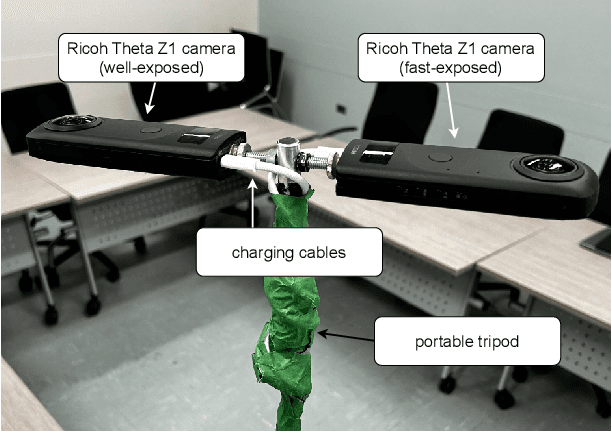
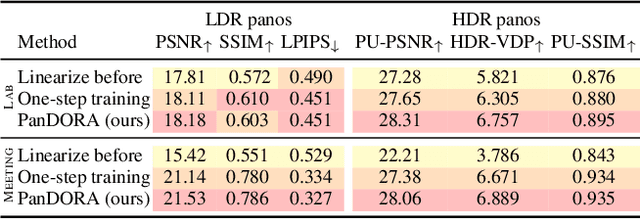
Abstract:Most novel view synthesis methods such as NeRF are unable to capture the true high dynamic range (HDR) radiance of scenes since they are typically trained on photos captured with standard low dynamic range (LDR) cameras. While the traditional exposure bracketing approach which captures several images at different exposures has recently been adapted to the multi-view case, we find such methods to fall short of capturing the full dynamic range of indoor scenes, which includes very bright light sources. In this paper, we present PanDORA: a PANoramic Dual-Observer Radiance Acquisition system for the casual capture of indoor scenes in high dynamic range. Our proposed system comprises two 360{\deg} cameras rigidly attached to a portable tripod. The cameras simultaneously acquire two 360{\deg} videos: one at a regular exposure and the other at a very fast exposure, allowing a user to simply wave the apparatus casually around the scene in a matter of minutes. The resulting images are fed to a NeRF-based algorithm that reconstructs the scene's full high dynamic range. Compared to HDR baselines from previous work, our approach reconstructs the full HDR radiance of indoor scenes without sacrificing the visual quality while retaining the ease of capture from recent NeRF-like approaches.
Towards a Perceptual Evaluation Framework for Lighting Estimation
Dec 13, 2023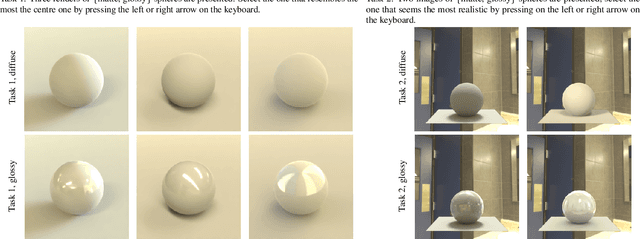
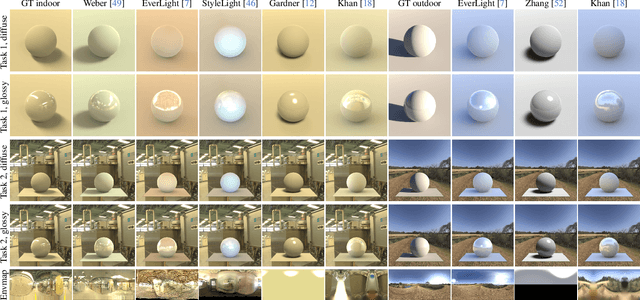
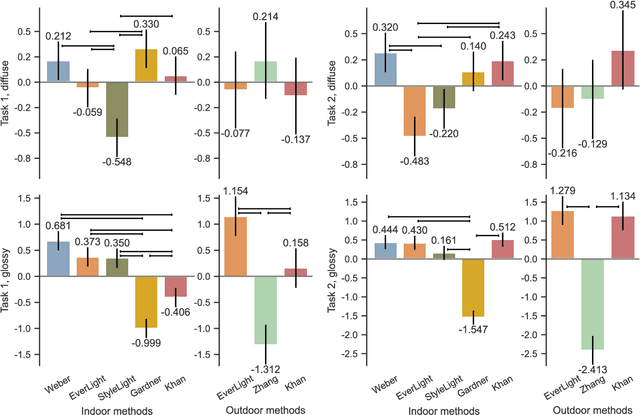
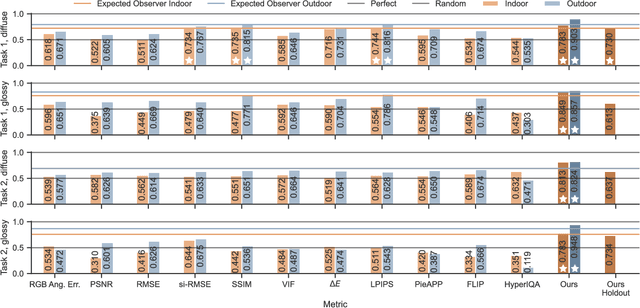
Abstract:Progress in lighting estimation is tracked by computing existing image quality assessment (IQA) metrics on images from standard datasets. While this may appear to be a reasonable approach, we demonstrate that doing so does not correlate to human preference when the estimated lighting is used to relight a virtual scene into a real photograph. To study this, we design a controlled psychophysical experiment where human observers must choose their preference amongst rendered scenes lit using a set of lighting estimation algorithms selected from the recent literature, and use it to analyse how these algorithms perform according to human perception. Then, we demonstrate that none of the most popular IQA metrics from the literature, taken individually, correctly represent human perception. Finally, we show that by learning a combination of existing IQA metrics, we can more accurately represent human preference. This provides a new perceptual framework to help evaluate future lighting estimation algorithms.
EverLight: Indoor-Outdoor Editable HDR Lighting Estimation
Apr 26, 2023


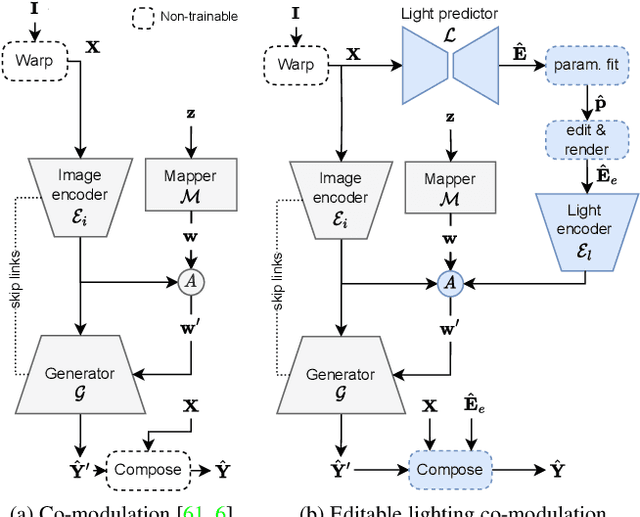
Abstract:Because of the diversity in lighting environments, existing illumination estimation techniques have been designed explicitly on indoor or outdoor environments. Methods have focused specifically on capturing accurate energy (e.g., through parametric lighting models), which emphasizes shading and strong cast shadows; or producing plausible texture (e.g., with GANs), which prioritizes plausible reflections. Approaches which provide editable lighting capabilities have been proposed, but these tend to be with simplified lighting models, offering limited realism. In this work, we propose to bridge the gap between these recent trends in the literature, and propose a method which combines a parametric light model with 360{\deg} panoramas, ready to use as HDRI in rendering engines. We leverage recent advances in GAN-based LDR panorama extrapolation from a regular image, which we extend to HDR using parametric spherical gaussians. To achieve this, we introduce a novel lighting co-modulation method that injects lighting-related features throughout the generator, tightly coupling the original or edited scene illumination within the panorama generation process. In our representation, users can easily edit light direction, intensity, number, etc. to impact shading while providing rich, complex reflections while seamlessly blending with the edits. Furthermore, our method encompasses indoor and outdoor environments, demonstrating state-of-the-art results even when compared to domain-specific methods.
Casual Indoor HDR Radiance Capture from Omnidirectional Images
Aug 16, 2022



Abstract:We present PanoHDR-NeRF, a novel pipeline to casually capture a plausible full HDR radiance field of a large indoor scene without elaborate setups or complex capture protocols. First, a user captures a low dynamic range (LDR) omnidirectional video of the scene by freely waving an off-the-shelf camera around the scene. Then, an LDR2HDR network uplifts the captured LDR frames to HDR, subsequently used to train a tailored NeRF++ model. The resulting PanoHDR-NeRF pipeline can estimate full HDR panoramas from any location of the scene. Through experiments on a novel test dataset of a variety of real scenes with the ground truth HDR radiance captured at locations not seen during training, we show that PanoHDR-NeRF predicts plausible radiance from any scene point. We also show that the HDR images produced by PanoHDR-NeRF can synthesize correct lighting effects, enabling the augmentation of indoor scenes with synthetic objects that are lit correctly.
Guided Co-Modulated GAN for 360° Field of View Extrapolation
Apr 15, 2022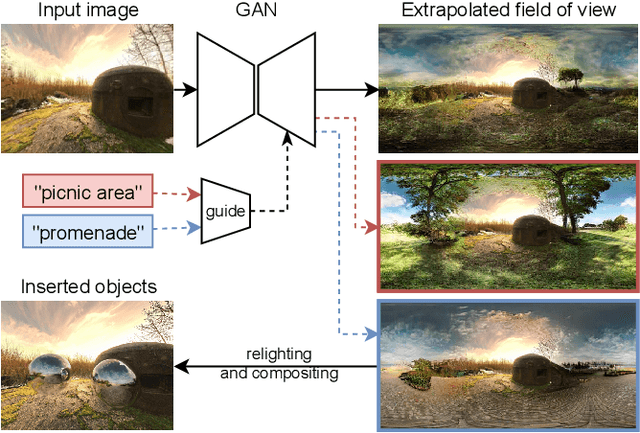


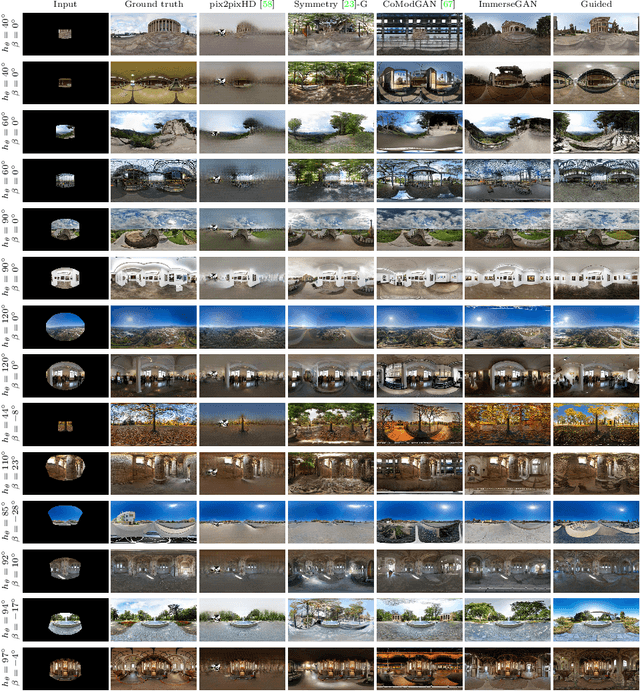
Abstract:We propose a method to extrapolate a 360{\deg} field of view from a single image that allows for user-controlled synthesis of the out-painted content. To do so, we propose improvements to an existing GAN-based in-painting architecture for out-painting panoramic image representation. Our method obtains state-of-the-art results and outperforms previous methods on standard image quality metrics. To allow controlled synthesis of out-painting, we introduce a novel guided co-modulation framework, which drives the image generation process with a common pretrained discriminative model. Doing so maintains the high visual quality of generated panoramas while enabling user-controlled semantic content in the extrapolated field of view. We demonstrate the state-of-the-art results of our method on field of view extrapolation both qualitatively and quantitatively, providing thorough analysis of our novel editing capabilities. Finally, we demonstrate that our approach benefits the photorealistic virtual insertion of highly glossy objects in photographs.
 Add to Chrome
Add to Chrome Add to Firefox
Add to Firefox Add to Edge
Add to Edge